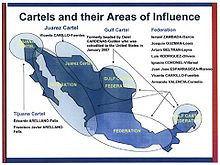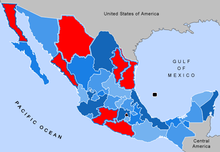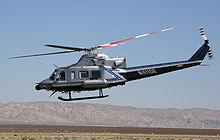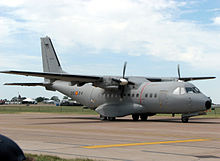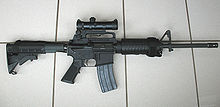- Mérida Initiative
-
The Mérida Initiative (also called Plan Mexico by critics) is a security cooperation agreement between the United States and the government of Mexico and the countries of Central America, with the declared aim of combating the threats of drug trafficking, transnational organized crime and money laundering. The assistance includes training, equipment and intelligence.
In seeking partnership with the United States, Mexican officials point out that the illicit drug trade is a shared problem in need of a shared solution, and remark that most of the financing for the Mexican traffickers comes from American drug consumers. U.S. law enforcement officials estimate that US$12 to 15 billion per year flows from the United States to the Mexican traffickers, and that is just in cash, i.e., not including the money sent by wire transfers.[1] Other government agencies, including the Government Accountability Office and the National Drug Intelligence Center, have estimated that Mexico's cartels earn upwards of $23 billion per year in illicit drug revenue from the United States.[2][3]
U.S. State Department officials are aware that Mexican President Felipe Calderón’s willingness to work with the United States is unprecedented on issues of security, crime and drugs,[4] so the U.S. Congress passed legislation in late June 2008 to provide Mexico with $400 million and Central American countries with $65 million that year for the Mérida Initiative. The initiative was announced on 22 October 2007 and signed into law on June 30, 2008.
Contents
Background
Mexico remains a transit and not a cocaine production country. Marijuana and methamphetamine production do take place in Mexico and are responsible for an estimated 80% of the methamphetamine on the streets in the United States,[5] while 1100 metric tons of marijuana are smuggled each year from Mexico.[6]
In 1990, just over half the cocaine imported into the U.S. came through Mexico. By 2007, that had risen to more than 90 percent, according to U.S. State Department estimates.[7] Although violence between drug cartels has been occurring long before the war began, the government used its police forces in the 1990s and early 2000s with little effect. That changed on December 11, 2006, when newly elected President Felipe Calderón sent 6,500 federal troops to the state of Michoacán to put an end to drug violence there. This action is regarded as the first major retaliation made against cartel operations, and is generally viewed as the starting point of the war between the government and the drug cartels.[8] As time progressed, Calderón continued to escalate his anti-drug campaign, in which there are now well over 25,000 troops involved.
During president Calderón's administration, the Mexican government has spent approximately $7 USD billion in an 18-month-old campaign against drug cartels.[9] It is estimated that during 2006, there were about 2000 drug-related violent deaths,[10] about 2300 deaths during 2007; more than 3,725 people have during 2008.[11][12] Many of the dead were gang members killed by rivals or by the government, some have been bystanders.[13][14] At least 450 police officers and soldiers have been killed since January 2007.[15]
The National Drug Intelligence Center (NDIC) has noted that cocaine availability decreased in several U.S. drug markets during the first half of 2007, mostly because of record 33.5 ton cocaine seizures by the Mexican Navy.[16] However, it is estimated that the major drug trafficking organizations are currently reorganizing and readjusting to the new challenges facing their trade; as a result, drug availability in 2008 is once again on the rise. One of the new adaptations is the use of home-made narco submarines; in 2006, American officials say they detected only three; now they are spotting an average of ten per month, but only one in ten is intercepted.[17] Another recent development is the consolidation of the smaller drug trafficking organizations into powerful alliances, escalating the violence between the groups vying for control of the narcotics trade to the U.S. Some 300 tons of cocaine are estimated to pass through Mexico to the U.S. yearly.[18]
Funding
The U.S. Congress has now authorized $1.6 USD billion for the three-year initiative (2007–2010). The U.S. Congress approved $465 million in the first year, which includes $400 million for Mexico and $65 million for Central America, the Dominican Republic, and Haiti. For the second year, Congress approved $300 million for Mexico and $110 million for Central America, the Dominican Republic and Haiti. A FY09 supplemental appropriation is providing an additional $420 million for Mexico; and $450 million for Mexico and $100 million for Central America has been requested for FY10.[19]
Only about $204 million of that, however, will be earmarked for the Mexican military for the purchase of eight used transport helicopters and two small surveillance aircraft. No weapons are included in the plan.[20][21][22] The bill requires that $73.5 million of the $400 million for Mexico must be used for judicial reform, institution-building, human rights and rule-of-law issues. The bill specifies that 15% of the funds will be dependent on Mexico making headway in four areas relating to human-rights issues, and on which the U.S. Secretary of State will have to report periodically to Congress.[23][24]
An additional $65 million was granted for the Central American countries (Belize, Costa Rica, El Salvador, Guatemala, Honduras, Nicaragua and Panama); the House also included Haiti and the Dominican Republic in this bill for Central America, which is a comprehensive public security package that seeks to tackle citizen insecurity in Central America by more effectively addressing criminal gangs, improving information sharing between countries, modernizing and professionalizing the police forces, expanding maritime interdiction capabilities, and reforming the judicial sector in order to restore and strengthen citizens’ confidence in those institutions.[25]
Much of the funding will never leave the United States. It will go toward the purchase of aircraft, surveillance software, and other goods and services produced by U.S. private defense contractors. While this request includes equipment and training, it does not involve any cash transfers or money to be provided directly to the Government of Mexico or its private contractors. According to U.S. State Department officials, 59% of the proposed assistance will go to civil agencies responsible for law enforcement, and 41% to operational costs for the Mexican Army and Mexican Navy. While the initial cost for equipment and hardware that the military required is high, it is expected that future budget requests will focus increasingly on training and assistance to civil agencies.
As of November 2009, the U.S. has delivered about $214 million of the pledged $1.6 billion.[26]
With the Mérida Initiative set to expire on September 30, 2010, the U.S. State Department has proposed a major renewal and expansion of the program. If approved, starting in 2011, $310 million would be granted to Mexico, another $100 million for the Central American Regional Security Initiative (CARSI), and $79 million for the Caribbean Basin Security Initiative (CBSI).[27]
Equipment
The Mérida Initiative will provide funding for:[28][29]
- Non-intrusive inspection equipment such as ion scanners, gamma ray scanners, X-ray vans and canine units for Mexico and Central America.
- Technologies to improve and secure telecommunications systems that collect criminal information in Mexico.
- Technical advice and training to strengthen the institutions of justice, case management software to track investigations through the system, new offices of citizen complaints and professional responsibility, and witness protection programs to Mexico.
- Thirteen Bell 412 EP helicopters (5 with INCLE funds for the Federal Police and 8 with FMF funds for the military).
- Eleven UH-60 Black Hawk transport helicopters (three with INCLE funds for the Federal Police and 5 with FMF funds for the Mexican Air Force), and three for the Mexican Navy.[30]
- Up to four CASA CN-235 transport aircraft.
- Equipment, training and community action programs in Central American countries to implement anti-gang measures and expand the reach of these measures.
Smuggling of firearms
The Mérida Initiative includes $74 million to be assigned for efforts by the U.S. government to stop the flow of illegal weapons from the U.S. to Mexico, but important concerns remain regarding how this will be achieved. According to a Mexican government official, as many as 2,000 weapons enter Mexico each year and fuel an arms race between competing drug cartels. Since 1996, the ATF has traced more than 62,000 firearms smuggled into Mexico from the United States.[31] Mexican government officials suspect that corrupt customs officials, on both sides of the border, help smuggle weapons into Mexico; as reported by ATF, the most common "traced" firearms now include the Colt AR-15 .223 caliber rifle, the AK-47 assault rifle, FN 5.7 caliber semi-automatic pistol and a variety of armor piercing .50 caliber long range sniper rifles and machine guns. Also, there have been occasions where grenade launchers were used against security forces and twelve M4 Carbines with M203 grenade launchers have been confiscated.[32][33][34] It is believed that some of these high power weapons were stolen from U.S. military bases.[35]
An analysis of firearms trace data by the Bureau of Alcohol, Tobacco, Firearms and Explosives (ATF) over the past three years shows that weapons are being traced to dealers in virtually every state, as far north as Washington state, and that Texas, Arizona and California are the three most prolific source states, respectively, for firearms subsequently illegally trafficked to Mexico.[36][37] Since 1996, the Bureau of Alcohol, Tobacco, Firearms and Explosives (ATF) has traced more than 62,000 firearms smuggled into Mexico from the United States.[31] ATF officials report that 90% of the firearms recovered in Mexico came from U.S. gun dealers,[38][39][40][41] and about 55% of these guns were identified as assault rifles.[42][43] However, the Department of Justice, Office of the Inspector General reported only 18,585 seized Mexican firearms were successfully traced to the United States in the last five years (2005–2009) out of 66,028 firearms submitted by Mexico to ATF for tracing.[44] Mexican officials submitted some 32% of the guns seized to the ATF for tracing. The ATF was able to trace less than half of the weapons submitted. Overall, 83% of the guns seized by Mexican authorities could not be traced.[45]
ATF has computerized millions of firearms sales transactions from dealer "out of business" records, and multiple sales reports, effectively creating a large de facto national firearms registry. If the firearm cannot be found in the computerized records, agents contact the manufacturer or importer with a make and serial number, then work their way down the supply chain by telephone or on foot.[46] ATF agents found that one in five of the seized Mexican guns could not be traced.[46]
In 2008, the ATF received 2 million USD to assist in the expansion of Spanish language eTrace software to Mexico and Central America region to assist them with firearms tracking issues, and their immediate goal is to deploy Spanish e-Trace software to all thirty-one states within Mexico.[47] ATF has provided Mexico (and Colombia) with its own centralized tracing center, staffed by nationals, with direct access to United States firearms transaction records maintained by the ATF National Tracing Center.
Since more work is required to make sure those guns stay in the U.S., the U.S. Senate proposes to stop firearms' smuggling now, which will allow Mexican law enforcement to fight drug trafficking more effectively; more importantly, it also takes the Mexican military out of the law enforcement role it has been assigned.[48] The ATF and U.S. Immigration and Customs Enforcement (ICE) recently implemented two enforcement initiatives named, Operación Armas Cruzadas (ICE) and Project Gunrunner (ATF). In early August 2008, the FBI is engaged in 146 task force investigations, 12 of them in Texas, aimed at drug-smuggling groups and gang activity.[49]
Criticism
The Mérida Initiative is called "Plan Mexico" by critics, to point out its similarities to Plan Colombia, through which the U.S. has heavily funded the Colombian military, yet cocaine production has steadily increased and registered a 27% rise in 2007,[50] before declining in 2008 and 2009 [51]
The current plan will require Mexican soldiers accused of human rights abuses in their country to face the civil courts rather than courts-martial. In response, members of the Mexican Congress raised objections because the conditions requiring monitoring of human rights violations are an infringement and violation of Mexican sovereignty,[52] a particular point of sensitivity because Mexico is concerned in exercising its right to govern over its own country without foreign intervention. Mexican authorities are understood to be much happier with the final wording of the package, which contains the phrase “in accordance with Mexican and international law” in at least three of the conditions relating to human rights.[53] The bill requires that $73.5 million must be used for judicial reform, institution-building, human rights and rule-of-law issues. Already some are concerned with the current amount of human rights abuses committed by the armed forces, some 800 in the first five months of 2008, double the rate from the year before. Most claims are filed for misconduct or illegal searches; yet some, though far fewer, are as serious as rape and torture. A growing number of citizens are concerned that the Mexican military is "becoming too powerful in the face of state weakness – a chilling reminder of a more repressive era."[54] Calderón's use of the army in fighting drug cartels has been questioned by rights groups, but political analysts say troops are his only real option in a country where as many as half the police could be in the pay of drug gangs.[55]
Some recent examples of Mexico’s paramilitary abuses include the sexual assault and rape of dozens of female detainees by police in San Salvador Atenco, and the disappearances of dozens of teachers in the rebellious state of Oaxaca in 2006, as well as the killings of seven innocent bystanders,[56] including the American journalist Brad Will by off-duty policemen.[57] Almost half of Mexican police officers examined in 2008 have failed background and security tests, a figure that rises to nearly 9 of 10 policemen in the border state of Baja California.[citation needed]
Others criticize the continued support of combating the supply of drugs rather than focusing on prevention, treatment and education programs to curb demand. Studies show that military interdiction efforts fail because they ignore the root cause of the problem: U.S. demand. During the early to mid-1990s, the Clinton administration ordered and funded a major cocaine policy study by the Rand Drug Policy Research Center; the study concluded that $3 billion USD should be switched from federal and local law enforcement to treatment. The report said that treatment is the cheapest and most effective way to cut drug use. President Clinton's drug czar's office rejected slashing law enforcement spending.[58] The Bush administration proposed cutting spending on drug treatment and prevention programs by $73 million, or 1.5%, in the 2009 budget.[59] The Fiscal Year 2011 National Drug Control Budget proposed by the Obama Administration will devote significant new resources to the prevention and treatment of drug abuse.[60]
Torture training
Human rights activists and other policy groups criticize the Initiative's lack of a robust framework for institution building and the existence of coerced confessions, often through the use of torture.[61][62] In early July 2008, a video emerged of city police officers from León, Guanajuato, being taught torture methods by a U.S. security firm instructor; the video created an uproar in Mexico, which has struggled to eliminate torture in law enforcement. It is still unclear how this event will affect the Mérida Initiative, as it can be used both to reinforce the need to train security forces on human rights or to cancel the initiative altogether.[63][64][65] The training took place in April 2006 and lasted for 12 days.[57] León Mayor, Vicente Guerrero Reynoso, initially insisted that the training would continue, justifying the training as a means of withstanding torture under kidnapping scenarios. However, because of the public furor and under pressure from federal and state authorities, he suspended the program.
A portion of the funding under the Mérida Initiative will be released only if the U.S. Secretary of State reports that Mexico bars the use of testimony that has been obtained through torture, a policy that is in line with Mexican law but often is not observed.[66][67]
Progress
On July 10, 2008, the Mexican government announced plans to nearly double the size of its Federal Preventive Police force in order to reduce the role of the military in combating drug trafficking.[68] The plan, known as the Comprehensive Strategy Against Drug Trafficking, also involves purging local police forces of corrupt officers. Elements of the plan have already been set in motion, including a massive police recruiting and training effort intended to reduce the country's dependence in the drug war on the military.[69] As part of the initiative, Mexico is already receiving information about suspicious ships leaving ports in Colombia and Ecuador.
On August 2008, Mexico announced that two states, Chihuahua and Nuevo León, are pioneering public trials, in which the state must prove its case. Before, the accused bore the burden of proof, and trials were secret. Mexico's president hopes this will bring transparency and accountability to the legal process and to end a tradition of corruption, shoddy investigations, coerced testimony, and an extremely low conviction rate.[70]
Early December 2008, the US released $197 million of aid to Mexico. Most of this aid will pay for helicopters and other equipment to fight violent drug cartels.[71] By early 2009 the US government released another $99 million which will go toward buying aircraft and inspection equipment for the Mexican military. The US has thus far released $300 million of the $400 million appropriated for Mexico.[72]
During the 5th Summit of the Americas in April 2009, the leaders of several Caribbean nations stated to a group of U.S. congressmen[dubious ] that they have a desire to join the Mérida Initiative, as a crackdown in Mexico could push drug traffickers' operations into their island nations.[73][dead link] This directly led to the formation of the Caribbean Basin Security Initiative (CBSI) as a complement of the Mérida Initiative.[74]
See also
- American Drug War: The Last White Hope
- Arguments for and against drug prohibition
- Decriminalization
- Demand reduction
- Drug policy
- Drug Policy Alliance
- Harm reduction
- Illegal drug trade
- Narco submarine
- Narcotrafficking in Colombia
- Law Enforcement Against Prohibition
- Legal history of marijuana in the United States
- Legal issues of cannabis
- Office of National Drug Control Policy
- Opium War
- Organized crime
- Plan Colombia
- Prohibition (drugs)
- United Nations Drug Control Programme
- Zero tolerance
References
- ^ Americans finance Mexican traffickers
- ^ Mexican Drug Cartels Move North
- ^ GAO Report on Drug Control, October 25, 2007
- ^ Thomas Shannon, Assistant Secretary of State 2009. (pdf)
- ^ "Mexico Security Memo: July 28, 2008". Stratfor. July 28, 2008. http://www.stratfor.com/analysis/mexico_security_memo_july_28_2008_0. Retrieved 2008-08-20.
- ^ "National Drug Threat Assessment 2006". Marijuana - Strategic findings. U.S. National Drug Intelligence Center. January 2006. http://www.usdoj.gov/ndic/pubs11/18862/marijuan.htm.
- ^ Bernd Debusmann: In Mexico's drug wars, bullets and ballads
- ^ "Mexican government sends 6,500 to state scarred by drug violence". International Herald Tribune. 2002-12-11. http://www.iht.com/articles/ap/2006/12/11/america/LA_GEN_Mexico_Drug_Violence.php.
- ^ Merida Initiative Will Help Battle Drug Trafficking
- ^ Mexico's drug war death toll tops 2,000 (2006)
- ^ No. 2 police officer in Mexican border city shot
- ^ Mexico drug wars suspected in deadly shootout
- ^ More kids caught in Mexico drug-war crossfire
- ^ Reuters - US, Mexico to meet on drugs in Washington next month (October 23, 2008)
- ^ Death toll
- ^ The 'Merida Initiative' Proposal
- ^ Waving, not drowning
- ^ Deaths climb in Mexico's drug war
- ^ "Merida Initiative: Myth vs. Fact". U.S. Department of State. June 23, 2009. http://www.state.gov/p/inl/rls/fs/122395.htm. Retrieved 2009-11-18.
- ^ Mexico's 2008 defence budget goes under review
- ^ Bush pushes Mexico money in Iraq bill
- ^ "Mérida Initiative" (PDF). Report to Congressional Requesters. United States Government Accountability Office. July. http://www.gao.gov/new.items/d10837.pdf
- ^ Welcome for US aid for Mexico’s drug war
- ^ House OKs funds to fight Mexican drug cartels
- ^ Central America and the Mérida Initiative
- ^ "U.S. releases US$214 million of Merida Initiative funds". Associated Press (ABC News). September 24, 2009. http://abcnews.go.com/International/wireStory?id=8468344. Retrieved 2009-11-18.[dead link]
- ^ "Understanding and Improving Mérida". Americas Quarterly. Pring 2010. http://www.americasquarterly.org/node/1491. Retrieved 2010-10-05.
- ^ "Status of Funds for the Mérida Initiative (December 3, 2009)". United States Government Accountability Office. CASEDE. December 3, 2009. http://www.casede.org/biblioteca/GAO-IM.pdf. Retrieved 2009-12-15.
- ^ "Firearms Trafficking". Government Accountability Office (GAO): pp. 10. 2009-06-09. "Over 90 percent of the firearms seized in Mexico and traced over the last 3 years have come from the United States."
- ^ EE.UU. entrega 3 "Black Hawk" a la Marina (September 15, 2011)
- ^ a b Editorial: Guns, ammo head south as drugs flow into U.S.
- ^ TIME -Civilian Victims in Mexico's Drug War
- ^ Time - Mexico's Narco-Insurgency
- ^ Detienen a 11 narcos al catear 3 casas en el DF
- ^ Armas robadas en EU, en poder de narcos
- ^ Mexico's massive illegal weapons
- ^ Feds raid gun store tied to Mexican drug cartels
- ^ Hoover, William (February 7). "Statement at the United States House of Representatives Committee on Foreign Affairs Subcommittee on the Western Hemisphere". Statement by William Hoover, Assistant Director for Field Operations, Bureau of ATF. Washington, D.C.: United States House of Representatives - Committee on Foreign Affairs. http://foreignaffairs.house.gov/110/hoo020708.htm.
- ^ McKinley, James C. (February 25, 2009). "U.S. Is Arms Bazaar for Mexican Cartels". The New York Times. http://www.nytimes.com/2009/02/26/us/26borders.html. Retrieved 2009-03-12.
- ^ "US House Foreign Affairs Subcommittee Calls for Action on Guns to Mexico". Latin American Herald Tribune. March 21, 2009. http://www.laht.com/article.asp?ArticleId=329899&CategoryId=14091. Retrieved 2009-03-21.
- ^ Lochhead, Carolyn (March 18, 2009). "Focus shifts to flow of cash, arms into Mexico". San Francisco Chronicle. http://www.sfgate.com/cgi-bin/article.cgi?f=/c/a/2009/03/17/MND616HC2C.DTL. Retrieved 2009-03-29.
- ^ "A lethal export to Mexico". The Boston Globe. March 4, 2009. http://www.boston.com/bostonglobe/editorial_opinion/editorials/articles/2009/03/04/a_lethal_export_to_mexico/. Retrieved 2009-03-14.
- ^ Testimony of Secretary Janet Napolitano before Senate - March 25, 2009
- ^ MNSBCmedia.msn.com
- ^ La Jeunesse, William; Maxim Lott (April 2, 2009). "The Myth of 90 Percent: Only a Small Fraction of Guns in Mexico Come From U.S.". Fox News. http://www.foxnews.com/politics/2009/04/02/myth-percent-guns-mexico-fraction-number-claimed/. Retrieved 2009-04-03.
- ^ a b McKinley Jr., James C. (April 15, 2009). "U.S. Stymied as Guns Flow to Mexican Cartels". New York Times. http://www.nytimes.com/2009/04/15/us/15guns.html?_r=1&partner=rssnyt&emc=rss. Retrieved 2009-04-17.
- ^ Statement by the Assistant Dir. for Field Operations of the ATF
- ^ Report to the U.S. Senate - page 9
- ^ U.S. officials praise Mexico for anti-drug efforts
- ^ Carroll, Roy (June 19, 2008). "Colombia's coca crop booms despite US-backed crackdown". The Guardian. http://www.guardian.co.uk/world/2008/jun/19/colombia.usa. Retrieved 2008-08-20.
- ^ Colombiareports.com
- ^ Human rights monitoring, a violation of Mexican Sovereignty: ap.google.com coha.org
- ^ Welcome for US aid for Mexico’s drug war
- ^ Military abuses rise in Mexican drug war
- ^ Reuters -Mexico rights panel slams army for drug war abuse
- ^ Mexico rights panel slams army for drug war abuse
- ^ a b Mexican torture videos reveal ties with US military contractors
- ^ Rydell, C. Peter; Susan S. Everingham (1994). "Controlling Cocaine: Supply Versus Demand Programs" (PDF). Rand Drug Policy Research Center. http://www.fathom.com/media/PDF/2184_cocainess.pdf.
*Cauchon, Dennis (June 14 1994). "White House balks at study urging more drug treatment". USA Today: 2A. http://bailey83221.livejournal.com/73026.html.
*Stokes, Doug; Noam Chomsky (Introduction) (2005). America's Other War: Terrorizing Colombia. Zed Books. ISBN 1-84277-547-2. OCLC 156752200. http://www.chomsky.info/articles/200412--.htm. p. xii, 87
*Donnelly, John (April 1 2000). "Narcotics Bill Reopens Drug War Debate Colombia Measure Spurs New Look At Us Policy". The Boston Globe. http://bailey83221.livejournal.com/73026.html#2.
*Cochran, John; Peter Jennings (September 22 1999). "A Closer Look". ABC News. http://bailey83221.livejournal.com/73026.html#2.
*Douglas, William (June 14 1994). "Best Weapon In Drug War Is Treatment". Newsday: A15. http://bailey83221.livejournal.com/73026.html#5.
*Douglas, William (June 14 1994). "U.S. Should Boost Therapy Of Coke Addicts, Study Urges". The Times Union. http://bailey83221.livejournal.com/73026.html#6. - ^ Gould, Jens E. (October 20, 2008). "Mexico's Drug War Veers Toward Terrorism Amid Anger Over U.S.". Bloomberg. http://www.bloomberg.com/apps/news?pid=20601087&sid=akDCw.fUKYOc&refer=home. Retrieved 2008-10-20.
- ^ Administration's FY 2011 Budget Proposal Demonstrates Balanced Approach to Drug Control February 1, 2010
- ^ Mexican police in 'torture' class?
- ^ Mexican Army Slammed for Drug War Torture
- ^ CNN News- Police 'torture' videos cause uproar in Mexico
- ^ ABC News- Police 'Torture' Videos Cause Uproar in Mexico
- ^ LA Times- Police 'torture' videos in Mexico cause worry
- ^ Helping Mexico and Human Rights
- ^ Lawson, Guy (March 4, 2009). "The Making of a Narco State". The Rolling Stone. http://www.rollingstone.com/politics/story/26435119/the_making_of_a_narco_state/print. Retrieved 2009-03-30.
- ^ Mexico Plan Adds Police To Take On Drug Cartels
- ^ Desarrollo institucional de la SSP
- ^ Iliff, Laurence; Alfredo Corchado (August 18, 2008). "2 Mexican states trying out new justice system". The Dallas Morning News. http://www.dallasnews.com/sharedcontent/dws/news/world/mexico/stories/081908dnjustice_19int.State.Edition1.4331aad.html. Retrieved 2008-08-19.
- ^ U.S. clears way for controversial drug aid to Mexico
- ^ U.S. frees $99 million more aid for Mexico's drug war
- ^ Wilkinson, Bert (April 19, 2009). "Caribbean asks US to expand anti-drug Merida plan". The Washington Post. http://www.washingtonpost.com/wp-dyn/content/article/2009/04/18/AR2009041802474.html. Retrieved 2009-04-24.
- ^ Carmichael, Lachlan. "US convenes Caribbean officials to fight drug-trafficking". CaribbeanNetNews.com. http://www.caribbeannetnews.com/news-23366--39-39--.html. Retrieved 29 May 2010.
External links
- Official Mexican web site for the Merida Initiative
- The Mérida Initiative: United States – Mexico – Central America Security Cooperation
- Woodrow Wilson Center's Mérida Initiative Portal Comprehensive site that features several resources
- Plan Mexico Foreign Policy In Focus, 30 October 2007
- Just don't call it Plan Mexico The Economist, 25 October 2007
- La Jornada article on proposal (Spanish)
- The Mérida Initiative and Citizen Security in Mexico and Central America from WOLA
- The Mérida Initiative: "Guns, Drugs and Friends" Minority Staff Report to Senate Committee on Foreign Relations, Dec 2007. (PDF) Contains useful breakdown of proposed funding
- A Primer on Plan Mexico by Laura Carlsen of the Americas Program, Center for International Policy - critique of the Mérida Initiative
- Mexico and the Mérida Initiative -- from Amnesty International
Mexican Drug War (2006–present) (Names in italics represent dead or arrested individuals) Federal forces Mexican Army • Mexican Air Force • Mexican Navy • GAFE • Federal Investigations Agency • SIEDO • Federal PoliceBeltrán-Leyva Cartel
(Extinct in 2010)FoundersArturo Beltrán Leyva • Alfredo Beltrán Leyva • Carlos Beltrán Leyva • Edgar Valdez Villarreal • Sergio Villarreal Barragán • Héctor Beltrán LeyvaLa Familia Cartel
(Extinct in mid-2011)FoundersNazario Moreno González • Carlos Rosales Mendoza • Arnoldo Rueda Medina • Dionicio Loya Plancarte • Rafael Cedeño Hernández • Alberto Espinoza Barrón • Enrique Plancarte Solís • José de Jesús Méndez Vargas • Servando Gómez MartínezGulf Cartel FoundersLeadersJuárez Cartel
(Armed wing: La Línea)FoundersLeadersKnights Templar Cartel
(Armed wing: La Resistencia)FoundersEnrique Plancarte Solís • Servando Gómez MartínezLeadersEnrique Plancarte Solís • Servando Gómez MartínezSinaloa Cartel
(Armed wing: Gente Nueva)FoundersLeadersTijuana Cartel FoundersRamón Arellano Félix • Benjamín Arellano Félix • Francisco Rafael Arellano Félix • Carlos Arellano Félix • Eduardo Arellano Félix • Francisco Javier Arellano FélixLeadersEnedina Arellano Félix • Luis Fernando Sánchez Arellano • Edgardo Leyva EscandonLos Zetas Cartel FoundersLeadersSee also Other cartelsEarly drug lordsSome corrupt officialsJesús Gutiérrez Rebollo • Victor Gerardo Garay Cadena • Arturo Durazo Moreno • Noé Ramírez Mandujano • Ricardo Gutiérrez Vargas • Rodolfo de la Guardia García • Francisco Navarro Espinoza • Raúl Salinas de Gortari • Julio César Godoy ToscanoOperationsMérida Initiative • Project Gunrunner • Project Coronado • Operation Solare • Operation Xcellerator • Operation Michoacan • Operation Baja California • Operation Sinaloa • Joint Operation Nuevo Leon-Tamaulipas • Operation Chihuahua • Operation Quintana RooVehiclesVariousTimeline of the Mexican Drug War • Édgar Eusebio Millán Gómez • Enrique Camarena • Jaime Jorge Zapata • War on Drugs • House of Death • Piracy in Falcon Lake • List of massacres in Mexico • Most wanted Mexican drug lords • Blog del NarcoCategories:- Drug control law
- History of drug control
- United States – North American relations
- Politics of Mexico
- Military of Mexico
- Mexican Drug War
- Organized crime events in Mexico
- Organized crime events in the United States
Wikimedia Foundation. 2010.

